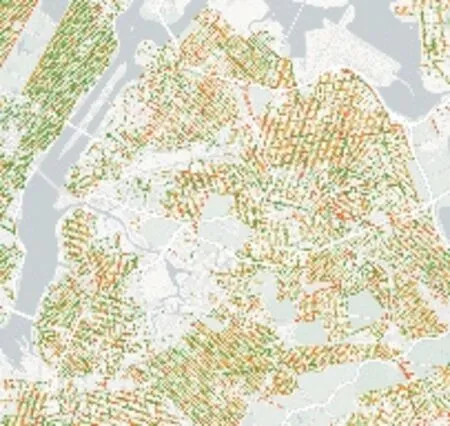大数据驱动的人居环境提升
2021-04-19郑曦

冬至日是年末最重要的节气,开始“提冬数九”,直到“九九”春暖花开,周而复始。二十四节气是古人通过经年累月的观察与记录总结的传统经验,同样的历史数据还包括对星象、气温、洪水、物候等的详细记载,通过这些数据发现物换星移、四时之变的规律,数据的收集与分析促进了古人对自然规律的认知和生产生活方式的塑造。
当今数据的收集方式产生了变革,认知的速度也呈几何级数增加。大数据逐渐成为日常生活的一部分,随着社交媒体的爆炸式发展,我们每个人日常行为轨迹都成为了数据源,例如手机信令数据、微博大数据、公交刷卡大数据等。这些数据的数据量大,处理过程复杂,公众成为参与收集、分类、记录或分析数据的主体。大数据所带来的改变是全领域的,也是颠覆性的。依靠专业的数据分析来解决规划设计问题,是对传统意义上规划设计与分析框架的补充,但是面对复杂的海量数据,如何处理并合理使用数据也成为当前人居环境规划设计实践的主要挑战。
在大数据技术革命的新环境下,用于支撑规划设计分析的大数据,可以更及时、精确地找到问题所在,为优化方案的运行方式提供一定科学依据。数据能否真正“增强”设计呢?很多学者结合最新的科学与技术,开展了探索性研究与实践。多源数据的出现在很大程度上提升了设计师对不同尺度场地的识别能力,设计师可以通过大数据获得在地调研之外的更丰富和更大尺度的空间信息,例如土地利用、大范围人群的景观感知等,这些都对规划设计起到重要的辅助支撑作用,展现出大数据辅助规划设计的强劲态势。宏观层面上,聚焦于新型城镇化背景下城市群绿色空间的统筹规划、绿道体系规划以及大中尺度的自然保护地规划等内容,通过对共享卫星遥感数据、土地利用资料、气象数据等空间、时间层面的原始数据进行转换处理,得到清晰明确、重点突出的可视化信息,进一步提出应对城市灾害风险、缓解城市生态压力的景观系统。微观层面上,大数据在设计中的应用更多体现在利用手机信令数据、街景数据以及公交刷卡数据等多种类型的移动信息对不同人口需求做出不同的响应,提出针对性的设计对策,并广泛应用在具体实践中。
但大数据并不是万能的,首先表现在数据精度与研究空间尺度的匹配问题上,例如口袋花园是居民日常休闲的重要场所,但是由于信号基站分布范围远大于口袋花园的分布范围,设计师很难通过手机信令数据准确判断口袋花园的游憩行为;其次,大数据内容与研究内容较难直接匹配,数据仅仅表现为单一的分布特征,其逻辑远达不到规划设计的复合特征要求,如何让数据服务设计,实现“增强”设计是重要的研究方向。
与人居环境直接相关的自然环境与历史数据均可成为“增强”设计的大数据类型,客观认知大数据、合理使用大数据是学科发展的重要途径。只有不断提高对大数据专业化应用的理解力和洞察力,让数据服务助力设计师更敏锐地感知和体验人居环境的变化与特质,提出基于大数据分析的创造性解决方案,引导未来人居环境与未来生活的新形态和新场景才是根本目的。

Living Environment Improvement Driven by Big Data
The day of Winter Solstice is the most important solar term at the end of year. Starting from “the 1st nine-day-period entering winter” until “the 9th nine-day-period” indicating spring blossoms, the cycle always repeats itself. The twenty-four solar terms are traditional experiences summarized from ancient years’ observations and records. The similar historical data also include detailed records of astrology, temperatures, floods, phenology, etc. Through these data, it is possible to identify the laws of changes of nature and stars as well as the shifts of seasons. In a word, the collection and analysis of data promoted the ancient people to recognize natural laws and shape their styles of production and life.
With innovation in the ways of data collection today, the speed of cognition has also been boosted exponentially. Big data have gradually become a part of daily life. With the explosive development of social media, the daily behavior trajectories of each of us have become data sources, for example, mobile phone signaling data, social media big data, bus card big data and the like. The massive data entails complex processing procedures. And the public has become the subject to participate in the collection, classification, recording or data analysis. The changes brought about by big data are all-inclusive and disruptive. Relying on professional data analytic to address planning and design problems is a supplement to the traditional framework of planning, design and analysis. Nevertheless, in the face of complex and massive data, how to process and reasonably use data has also become a major challenge in current research, planning and design practices by the disciplines related to living environment.
Under the new environment of big-data technology revolution, the big data used to support the planning and design analyses can pinpoint problems in a more timely and accurate manner, while providing a scientific basis for optimizing the operation of solutions. Can data really “enhance” the design? In combination of the latest science and technology achievement, many scholars have implemented exploratory research and practice, showcasing the strong momentum of big-data assisted planning and design. The emergence of multi-source data has greatly boosted designers’ ability to identify the sites of different scales, because they are able to, via big data, acquire richer and larger-scale spatial information beyond on-site surveys, such as information on land use, the landscape perception of a large range of people, etc. All these methods play an important supporting role for planning and design. At the macro level, it focuses on the overall green space planning of urban agglomeration, greenway system planning and nature reserve planning in large and mediumsize under the background of new urbanization. Through the conversion and processing of spatial and temporal raw data such as shared satellite remote sensing data, land use data and meteorological data, clear and focused visualized information can be obtained, which can be used for reference while further putting forward the landscape system to deal with the urban disaster risk and relieve the urban ecological pressure. At the micro level, the application of big data in the design is more reflected in the use of mobile phone signaling data, street view data, bus card data and other types of mobile information to make various responses to the needs of different populations, to further put forward targeted design countermeasures, which could be widely used in specific practice.
However, big data are not a panacea. First of all, there is an issue of matching between the data accuracy and the space scale of research. For example, pocket garden is an important place for local residents’ daily leisure. However, because the signal base stations are distributed much more widely than the range of pocket garden, it is difficult for designers to accurately determine the recreational behavior around pocket garden via mobile phone signaling data. Secondly, it is uneasy to directly match the big-data contents and research contents, and the data could only demonstrate a single distribution feature, with its logic far from meeting the requirements of composite features of planning and design. It is still an important research field that how to enable the data to serve designs and realize “enhanced” designs.
Both the natural environment data and historical data directly related to living environment can become a big data type that can “enhance” designs. It is an important way for the discipline’s development to objectively recognize and rationally use big data. By continuously improve the understanding of and insight into the professional applications of big data, driving data services help planners more keenly perceive and experience the changes and characteristics of living environment, putting forward creative solutions based on big data analysis, and guiding new forms and new scenes of future living environment and future life are the fundamental purposes.
Editor-in-Chief: Professor ZHENG Xi
December 25, 2020
